Granicus | Public Records Requests
Role: UX lead | Granicus Product organization
Responsibility: Engaged in innovative ideation and extensive generative user research to define product vision and make the process for completing records requests more intuitive for users
UX Methodologies:
- Data analysis
- Define hypothesis
- Competitive Research
- Ideation
- User research:
- Storyboard scenario testing
- A/B storyboard scenario testing
- Research synthesis
- Workshop design
- Design Sprint
- Roadmap planning & prioritization
Impact:
- Defined strategic product vision and 5+ years worth of prioritized UX roadmap concepts proven to deliver high-impact value to users in five months
Once the concepts are delivered, we anticipate that we will achieve the following results as compared to current data:
- Reduce user time onboarding
- Increase CSAT
- Increase sales conversion
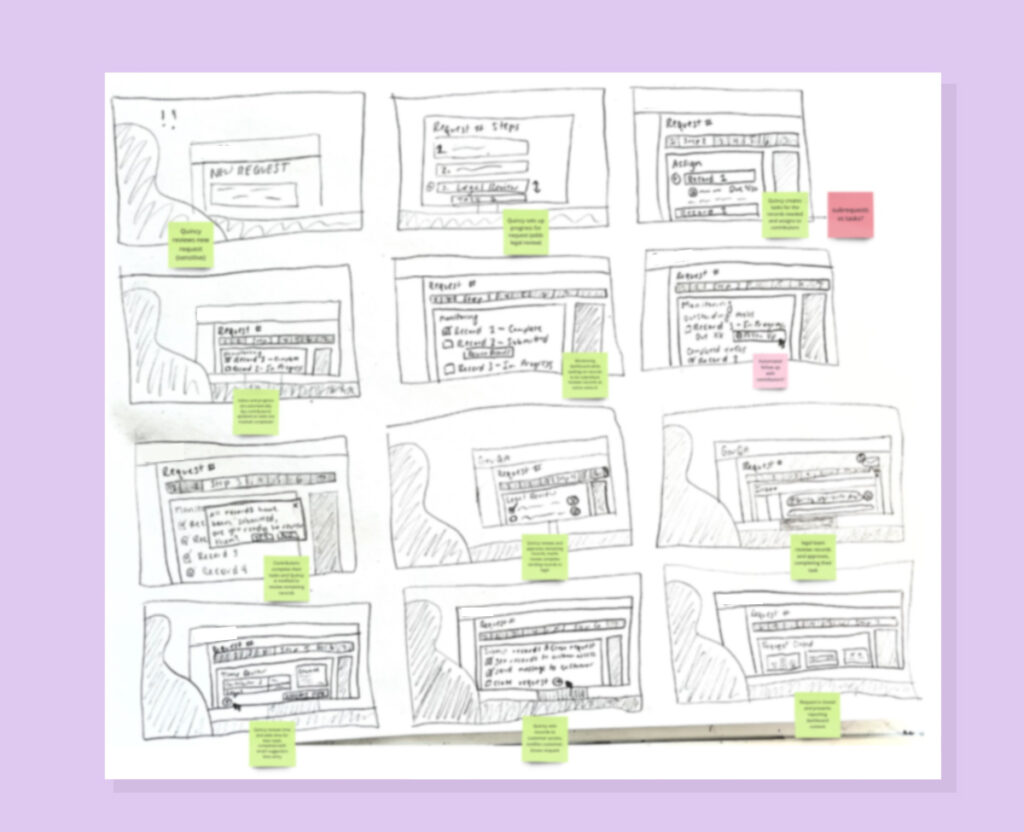
Background:
Who are the users?
- Public Record Officers
What problem is being solved?
- From previous user research, this product has consistently received user feedback that: ‘the product is great..once you get used to it’
- The goal of this project is to understand the challenges that make the product unintuitive to users and define concepts to solve those problems
How?
- Conduct generative user research and innovative ideation to define product vision and develop prioritized roadmap initiatives for improving user experience with product
Why?
- This is a rare opportunity identified to do large scale, generative user research that can define the future vision for this product and the concepts for this product’s UX roadmap for years to come
- Without conducting this more generative research to guide future UX initiatives for this product, it would be easy to fall into a pattern of addressing low-hanging fruit UX/UI improvements. These would of course be beneficial, but may not be able to provide as much impact to users as the concepts created from generative user research
When?
- A quick turnaround to prepare the concepts for ‘roadmap season’…yikes!
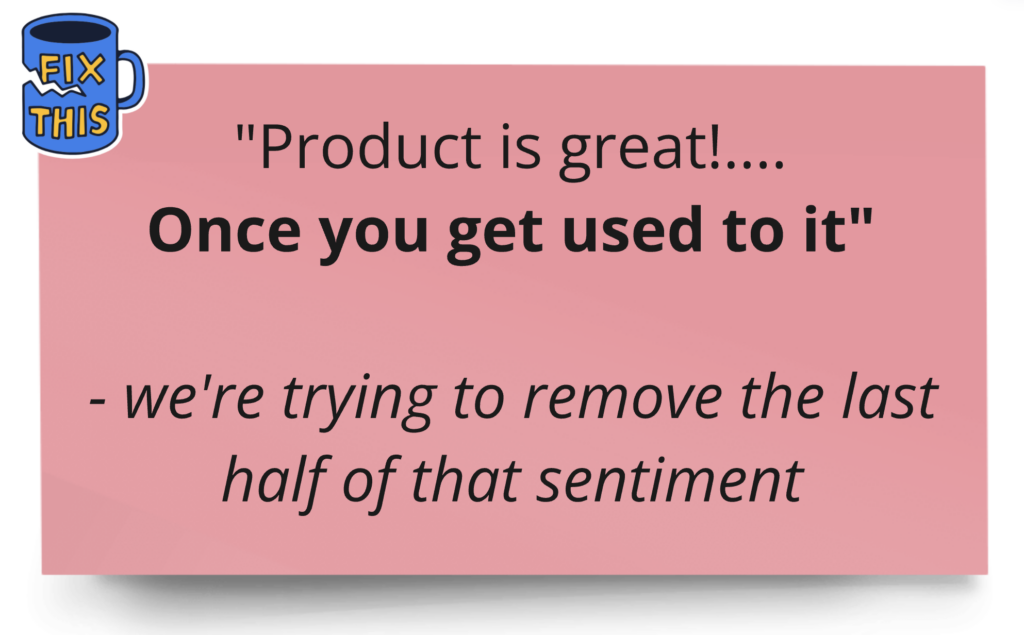
Process
In this project, I used the double diamond framework to guide my process. I like this map’s structure for its demonstration of diverging and converging processes throughout the project. I typically use this framework in projects when I have some direction toward what to solve, but still have many outstanding discovery needs to better understand user perspective on the problem. Previous research insights determined that the problem to solve is that the product is great, once you get used to it (unintuitive). That problem statement becomes my point A in this visual that I can refer back to at the end of the process (at point B) to validate the defined solution solves this problem.
*A note: I completed the majority of the double diamond process highlighted in purple. After I completed the roadmap prioritization exercise, I was shipped to a new product and project. Later on when this product team was ready to implement the first priority concept I defined, another designer was assigned to build, deliver, and validate the individual concept (blue section).
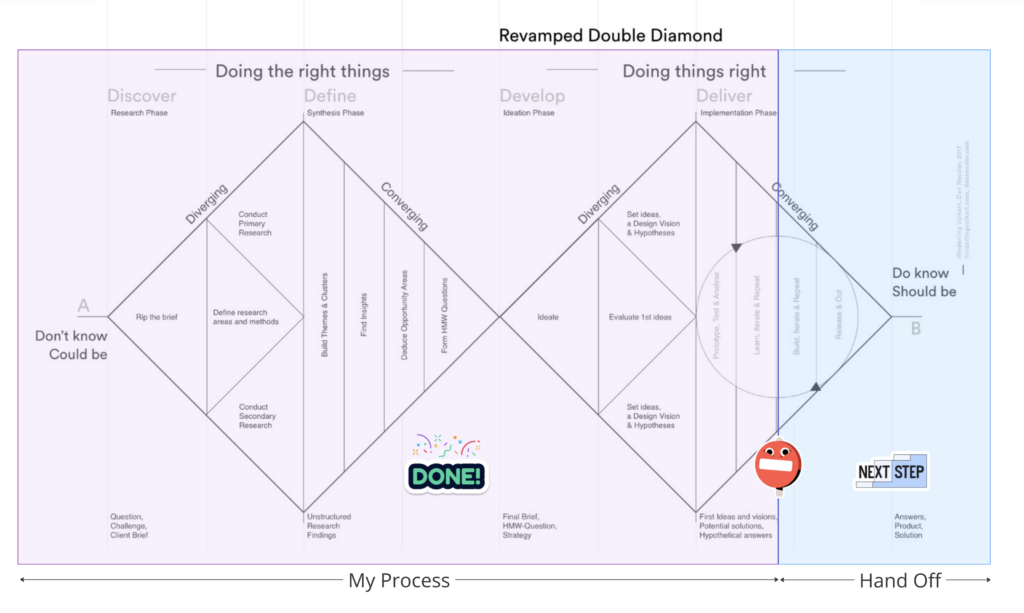
Visual by Dan Nessler via Medium: https://uxdesign.cc/
Phase 1: Discover (Research)
Goal
This first phase of discovery is a diverging process to gather all information possible that will inform understanding of the users. In this project, it is the first step in learning about the users actions, thoughts, feelings, and behaviors that might help us going forward to better understand what users find unintuitive about the product.
This phase of the project looked quite different from my normal process because this product (prior to acquisition by Granicus) had invested in research from an external consultant who provided various UX research services: including user interviews, a user journey map, a findings presentation, and more.
Project Kickoff
Starting this project, I prioritized connecting early with the cross functional team (UX, Product, and Engineering) to assist in ramping up on this product and to get further context into what we already know about the problem to solve. Especially because of the pre-existing research, this early project kickoff was a great way to ensure the team was aligned, that everyone had the same information, to identify other individuals or teams that would need to be involved or informed throughout the project, and to clarify expectations around the outcome of this work and the necessary timeframe. From this conversation, it was confirmed that the goal was to define what UX concept could be put on the upcoming year’s roadmap that would improve the product to be more intuitive for users.
Review Existing UX Research
One of the earliest steps of this project was reviewing the external consulting agency’s UX Research deliverables. Though I love starting from a blank slate and conducting my own research, it was very informative to start the project with a lot of insightful resources, artifacts, and findings, and these made the discovery process go much more efficiently. The agency had done very thorough research that provided valuable insights through the following deliverables:
- User interviews
- User journey map
- Findings deck
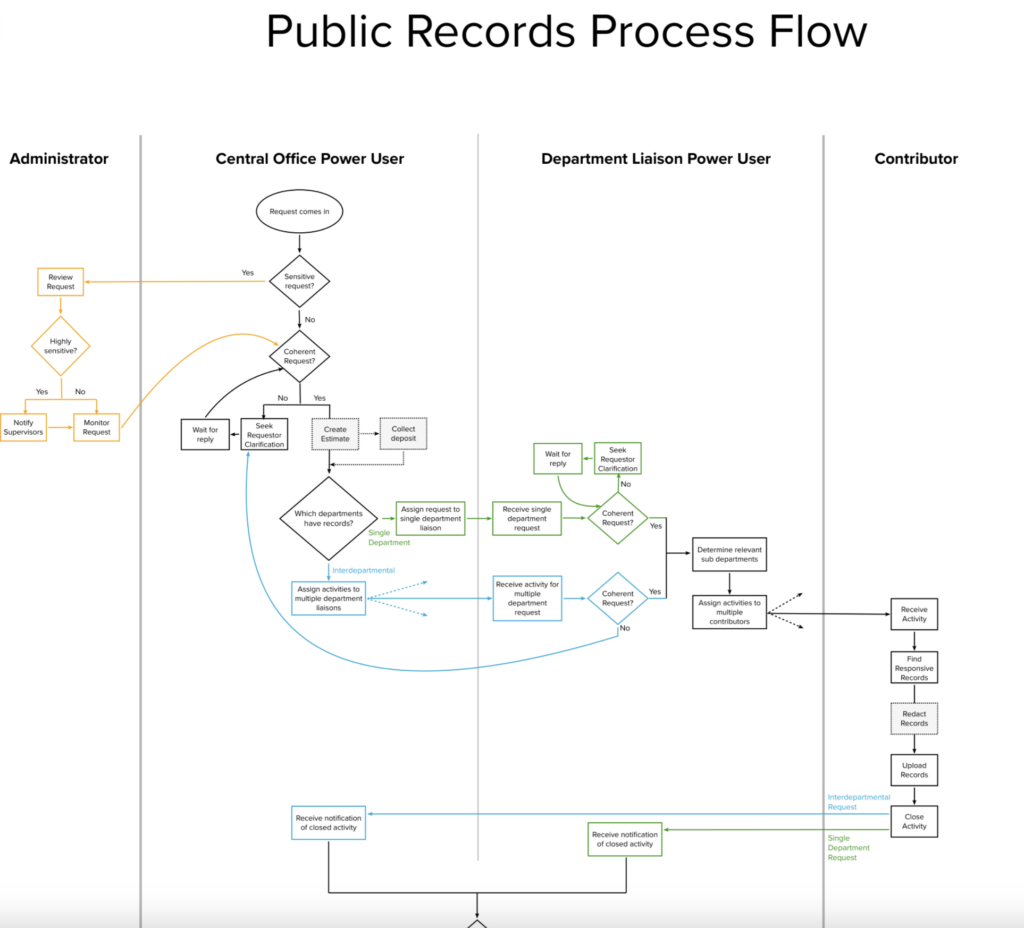
A brief preview of the user journey map created by the external research consultants.
Phase 2: Define (Synthesis)
Goal
From all of the data reviewed in the previous discover phase, the define stage of work was intended to analyze this data and develop a hypothesis that can be used going forward for ideation.
Discovery Data Synthesis
In reviewing all of the data from the agency’s research deliverables, I synthesized the findings to define intended outcomes. All of this data came together as three primary outcomes we hope to achieve by introducing innovation to the product’s experience:
- Easy, intuitive UI/UX that reduces the information overwhelm in the request module
- Make collaboration and monitoring across users and departments easier
- Simplify complex processes for users

Define Hypothesis
Once the primary outcomes for this work were defined, the next question needed to address is how to deliver these outcomes for users?
In a share-out where I presented the synthesized data to the cross-functional team, my manager came up with an idea that intrigued us all to study further. Her idea that became our hypothesis to experiment with was: ‘what if our request processing software followed a similar framework and used the best practices of project management software?’
After this discussion, I further studied the framework that defines project management software and found that the primary uses of these tools (plan, schedule, track, collaborate, report) aligned very nicely with what users of our product needed to complete their work. This solidified the direction to define this approach as our hypothesis to test through user research.

Phase 3: Develop (Ideation)
Goal: Round 1
This phase of work takes the hypothesis developed in the previous stage (request processing as project management) and turns it into concepts for how might we achieve our intended outcomes.
Competitive Research
It feels silly to re-invent the wheel when there are so many great project management softwares that have already been user-validated to pull inspiration from. So to start the ideation process, I studied existing project management software to get ideas for how to solve our product’s user problems and achieve our defined outcomes. Two examples of the competitors I researched for concept inspiration were Asana and Hubspot. Both had many concepts that could be used to solve our users’ problems, including these examples:
- workflow visualization
- dashboard landing page
- organizing data by criteria
- status management
- customizable views for conversations
- side sheet for quick preview and editing
- and more!


Ideation: Round 1
With our hypothesis and the concepts inspired by competitive research in mind, I set out to brainstorm how to use these ideas to solve the problems our users identified in the discover phase.
My favorite way to start my brainstorming process is to use a variation of the ‘crazy 8’s’ exercise to doodle lots of crazy ideas very quickly. I start with a blank sheet of paper and fill it with as many frames as possible. Once my spaces are set, I set a timer for 5 minutes and go one-by-one doodling a new idea in each frame. After filling out all these frames, I may create more if I continue to feel inspired. Once I feel that I am duplicating ideas with only small tweaks to differentiate, I stop and bring all of the sketches into Miro. The important reason I stop once I notice that I am making small tweaks to existing ideas is that I do not want to focus too closely on the details at this stage. It is important to remain at the conceptual high-level throughout this exercise as the implementation of these ideas will be studied later on.
Once I bring these conceptual sketches into Miro, I start to analyze the concepts for numerous factors:
- what problem is this concept attempting to solve for users?
- where in the user journey would this concept live?
- how impactful might this concept be in solving the problem for users?
- is this concept possible to implement for users?
- ideally there are numerous ways we can build this concept for users and have options that can be implemented with both low and high levels of effort
After assessing the concepts through the lens of these questions, I create a storyboard that depicts a conceptual user journey of processing a public record request that incorporates several of these concepts throughout. This storyboard will be presented to users to understand the value that these concepts might bring to their experience.

Phase 4: Deliver (Prototype & Test)
Goal: Round 1
In developing the research plan from the previous ideation phase, I decided to break up user research into two phases. Our hypothesis around project management software lead to lots of concepts that are auxiliary concepts (not directly impacting the request module, but impact the user experience of processing requests) and address the defined outcomes:
- Make collaboration and monitoring across users and departments easier
- Simplify complex processes for users
But the concepts for this hypothesis are less directly impacting the outcome:
- Easy, intuitive UI/UX that reduces the information overwhelm in the request module.
Noting this, I determined to do (at least) two rounds of user research to first determine what concepts users valued for improving the collaboration and simplification of complex process outcomes. Then after this research was complete, I would go back to the drawing board for further ideation and to develop a research plan intended to learn how to make the request module UI/UX more intuitive for users.
User Research Methodology: Round 1
The methodology used for this research is called storyboard scenario testing. In this process, I present our participants with a conceptual workflow of a user’s process completing records requests. I go frame-by-frame introducing concepts at each step of the user journey through this scenario and receive feedback on these whether or not these new concepts would improve the user’s experience.
As a note, I ensure users understand that these concepts are purely conceptual and that the team has made no guarantee to create this functionality in the product, but that these concepts are presented to understand if they will benefit users’ processes.
For the participant profiles, I defined the following guidelines:
- Sample size tentatively = 5. I planned to recruit at least 8 participants, but defined five as statistical significance based on the generally defined point of diminishing return for qualitative research as defined by NNG.
- Participant criteria: request processing staff (not administrators, legal counsel, etc.).
- Current app users of live, active accounts (none in implementation).
- Individual, semi-structured interviews
User Research Concepts: Round 1
In this research, some specific new concepts I presented were:
- a request inbox concept attempting to improve communication between team members regarding a specific request
- new visualization configurations attempting to enhance monitoring request progress and deadlines across individuals and teams
- automation in some processes in an attempt to simplify complex processes and reduce manual steps for users
- and many more!
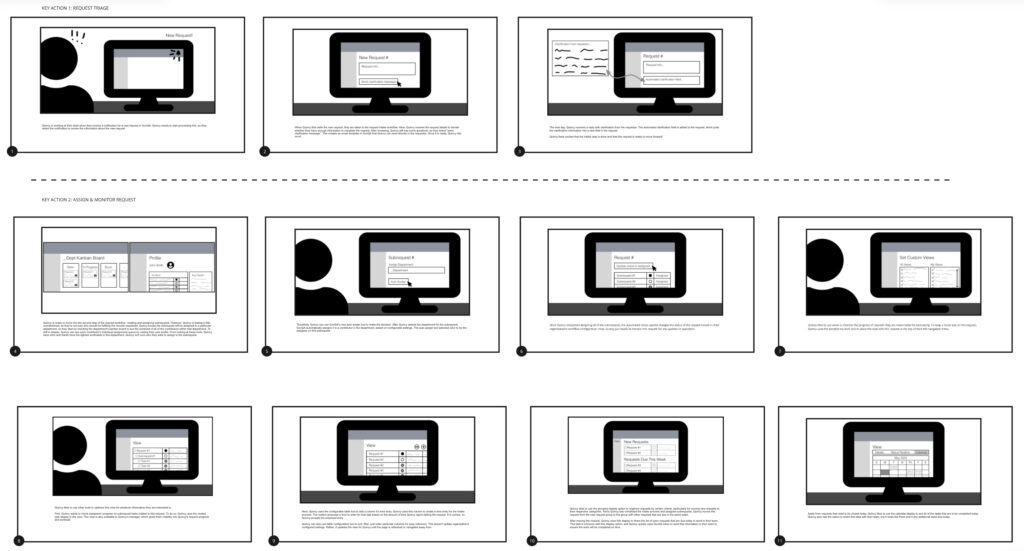
User Research Analysis: Round 1
Some of the concepts presented to users were home runs that received extremely positive feedback from users that expressed great impact for improving their experience. Some concepts were determined to be too risky for users to trust the accuracy of implementing them correctly. And other concepts were deemed as helpful, but the responses were not expressing enough impact to pursue them at this time.
Using analysis based on the frequency and significance of the feedback, I created insights to deliver a compelling story on the top concepts and how they would benefit users for the stakeholder team. I then outlined the takeaways from our tested concepts as a prioritized concept list for roadmapping considerations.
User Research Outcomes: Round 1
Synthesizing the feedback from user research, a prominent narrative that emerged from user insights was that the greatest challenge they had in completing their work of processing requests was in collaborating with team members and monitoring the progress of the request.
The most positively received concept was an inbox that would store all communications related to a request and more intuitively present conversations around request processing to users.
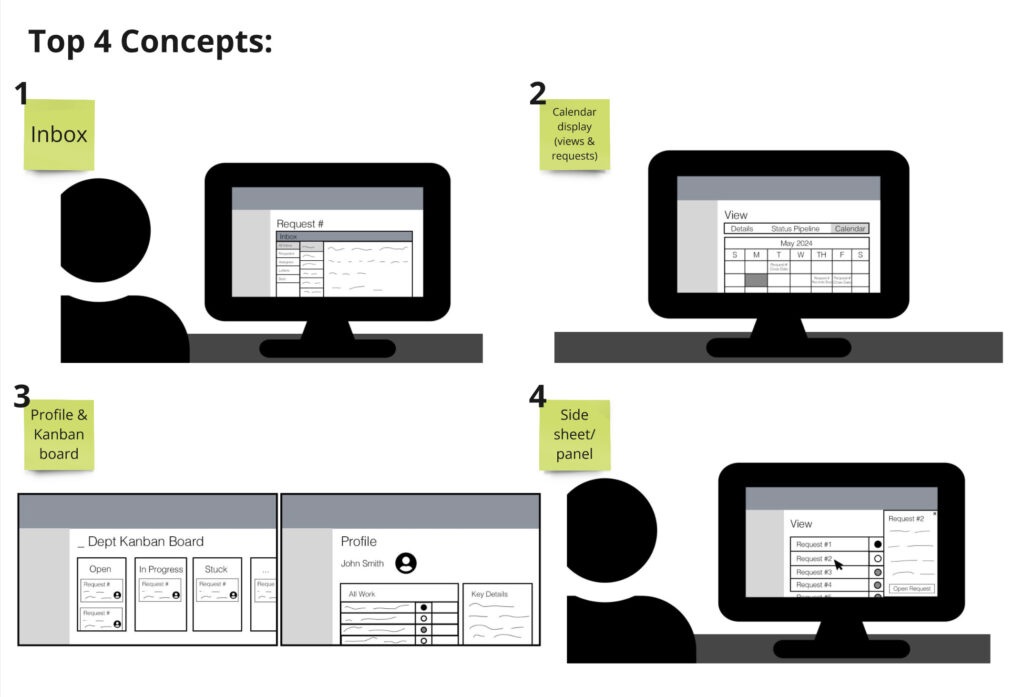
Phase 3: Develop (Ideation)
Goal: Round 2
The first round of research was informative in defining the impact of the top auxiliary concepts added to the existing user journey of request processing, but there needed to be additional research to determine if a new workflow would better support users’ journey to complete their work.
Ideation: Round 2
Went back to the drawing board to start ideation, seeking innovative ways to make the request module in the product more intuitive.
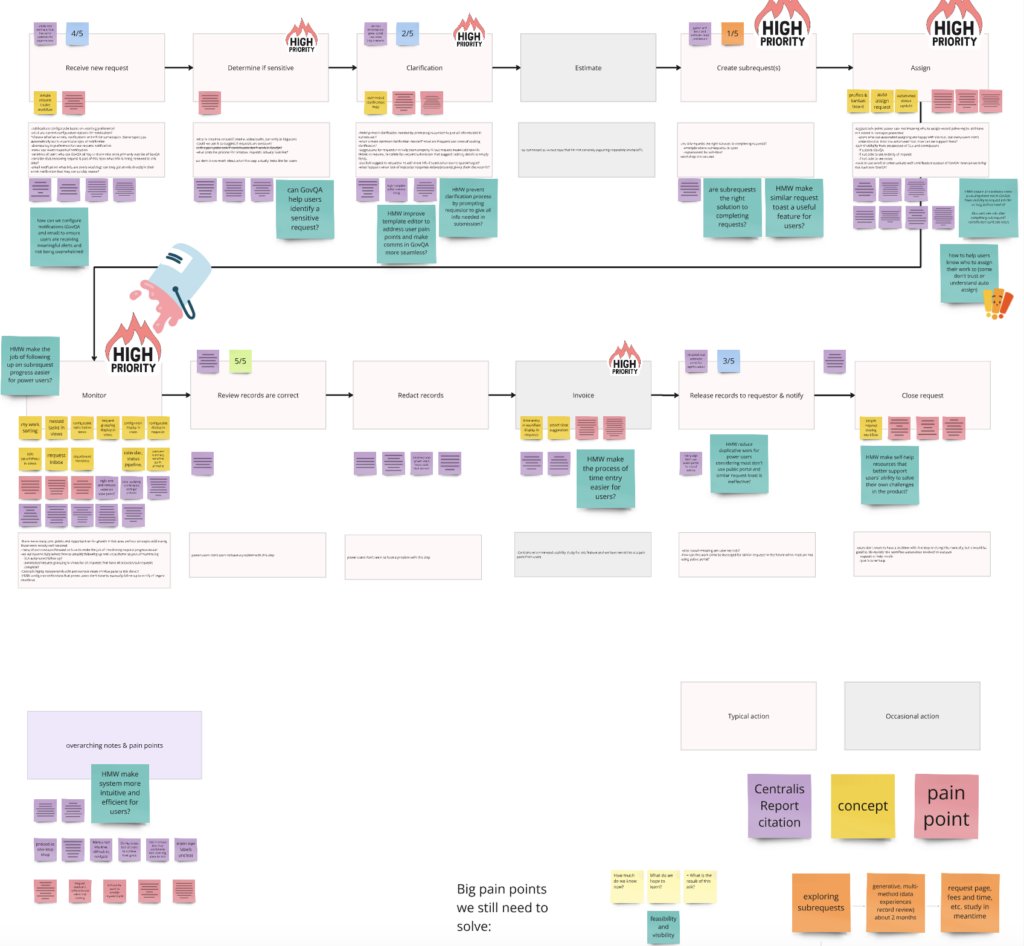
Stakeholder Workshop
Designed and planned a stakeholder workshop to align stakeholders on the problems we are working to solve through this work and host collaborative brainstorming sessions to come up with solution ideas to test with users.
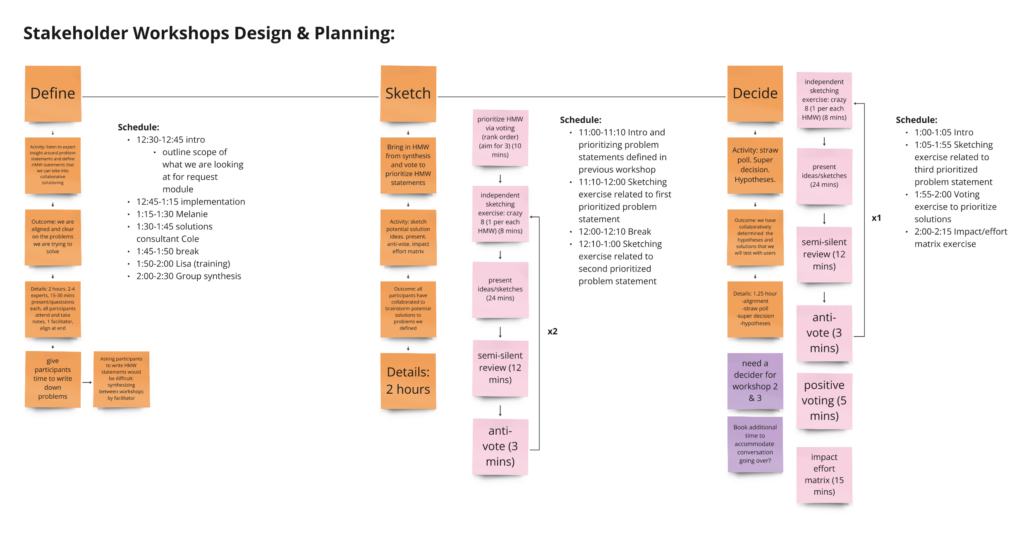
Phase 4: Deliver (Prototype & Test)
Goal: Round 2
In this stage, the goal is to assess the value to users of two new conceptual models of the request module (compared to each other and the auxiliary concepts we previously researched).
User Research Methodology: Round 2
Conducted A/B Storyboard Scenario test to present users with a content-based request module and a progress-based request module to see which they would prefer for their own process.
User Research Concepts: Round 2
Content-based request module:
- Similar conceptually to existing request module in that users find the information they need based on what content they are looking for (details, related files, invoicing, etc.)
- Added a concept for a dashboard that would be a widgetized, configurable landing page for the request that is intended to present users primary needs for information and actions
- Simplified the IA within the request module from 10 tabs to 5 by re-categorizing and re-labeling the content in an attempt to reduce information overwhelm
Progress-based request module:
- Presents new conceptual model for how users might complete processing requests through a guided approach that takes users through the steps to complete their work
- This concept was created to learn if a guided approach would support users through the complexities of processing a request and if it could help new users learn the product more efficiently
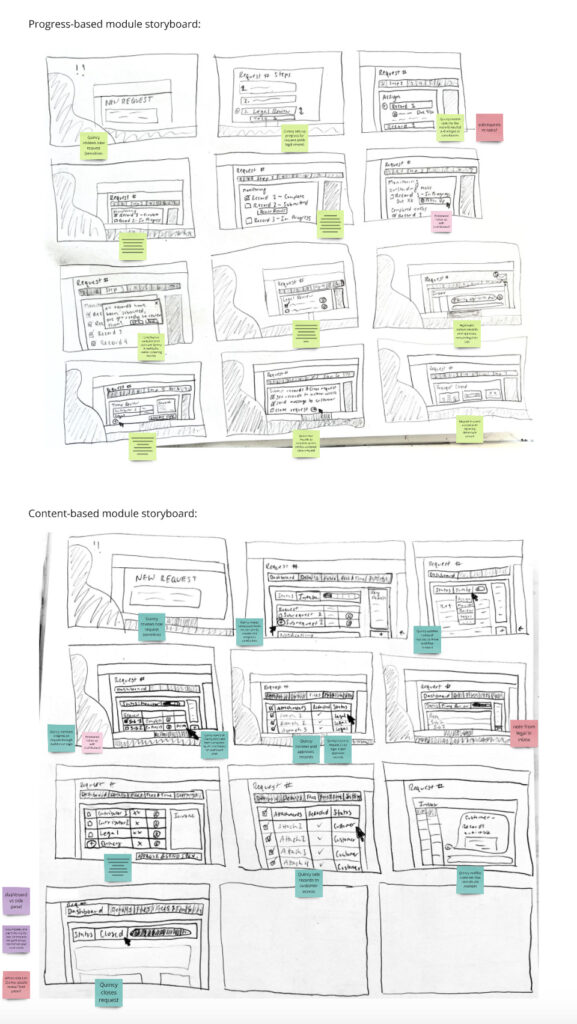
User Research Analysis: Round 2
Overall, users preferred the content-based module over the progress-based module, citing a few specific reasons:
- Preference for the similarity of the content-based module workflow to their current process
- Concerns that though the progress-based module could be helpful in some cases, but it may cause additional work for processing a request that is more complex and can’t be completed in a linear fashion
- The dashboard concept added to the content-based module presents additional value over the existing request module
This information was insightful in determining the future direction of the request module for this product, but neither request module workflow surpassed the overwhelming positive feedback from users when compared to some of the auxiliary concepts from the previous round of research. Analyzing the two rounds of research together confirmed that the top concepts from the first round of research have greater impact to users than the workflow changes tested in the second round of research. Therefore, we will prioritize those concepts in our roadmap planning.
User Research Outcomes: Round 2
We are confident that users are open to change and find the concept of a content-based approach to the request module helpful, but that this concept is not as impactful as many of the concepts from the previous round of research. Therefore introduction of this concept for the request module will not be introduced until we’ve completed implementing the concepts users found more valuable.
Outcome
Insights & Roadmap
Created prioritized roadmap from insights gathered through the two rounds of user research.
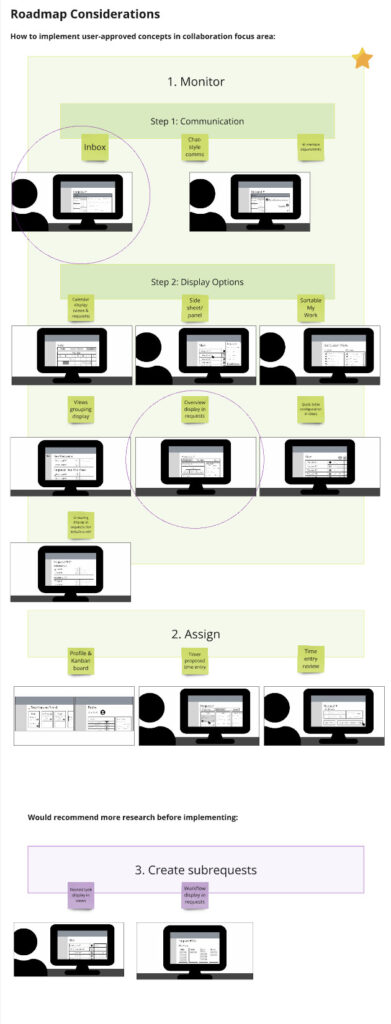
Conclusion
Through this process, I delivered a prioritized queue of UX roadmap concepts that will inform product innovation for years to come and that will benefit the user experience working in the product. I also identified the highest impact concept to users and made the recommendation that this concept be included in the upcoming year’s roadmap.
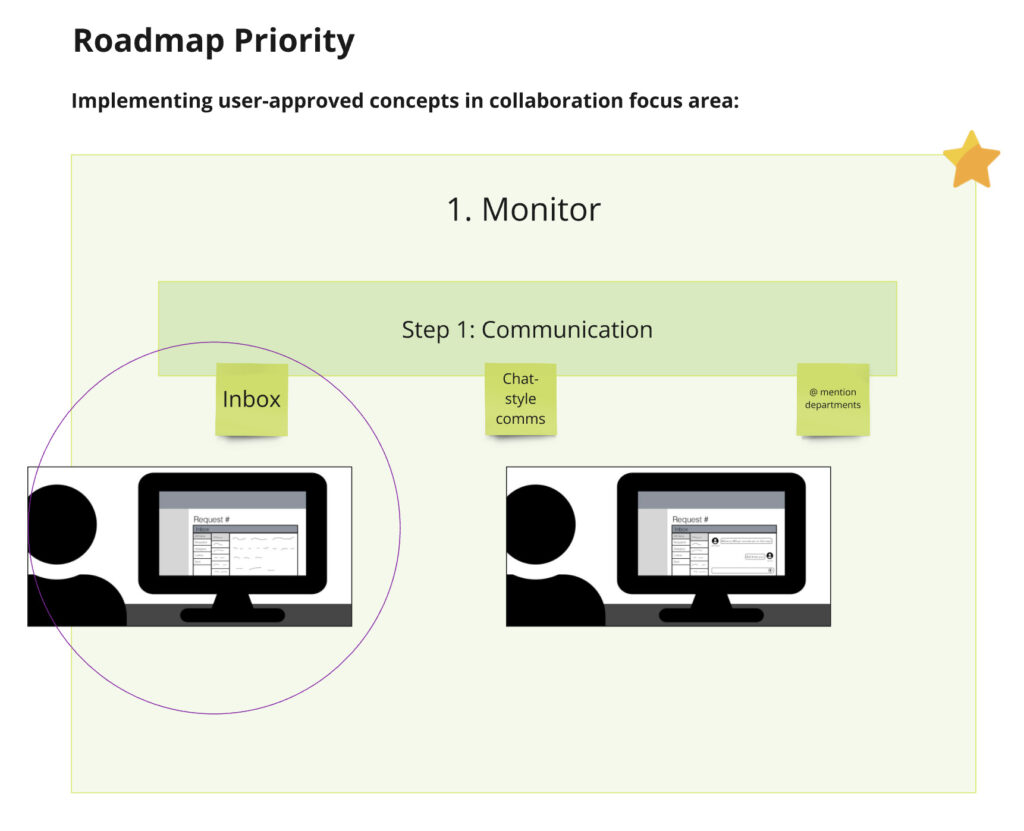
Project Team:
Senior Manager of Product Design: Amy Breitkreutz
UX Researcher: Peyton Westman
Product Designer: Talia Roth
Director of Product Management: Jann Curtis
Product Manager: Dan Huizinga
Workshop Participants: AJ Warzecha, Dan Huizinga, Jaymee O’Grady, Julie Proffitt, Shivam Patel

